Japan Wood Products
Prices
Dollar Exchange Rates of
12th March 2013
Japan Yen
96.04
Reports From Japan
Bank of Japan maintains aggressive stance
The Bank of Japan (BoJ) issued a press release after the Monetary Policy
Meeting held March 7.
http://www.boj.or.jp/en/announcements/release_2013/k130307a.pdf
The BoJ noted that while overseas economies remain weak they are showing
some signs of improvement. The BoJ further noted that Japan's economy has
stopped weakening.
The decline in Japan’s exports has been halted and, while fixed investment
in the private sector continues to be subdued, there are some positive signs
in the non-manufacturing sector.
In contrast, public investment has continued to increase and housing
investment has grown. Private consumption continues to be positive and this
is supporting an improving business outlook.
Reflecting on these developments in demand both at home and abroad the BoJ
press release said Japan's economy is expected to level off and to return to
a moderate recovery path driven mainly by domestic demand and improvements
in overseas economies.
In terms of risks, there remains a high degree of uncertainty concerning
Japan's economy. Of particular concern is the European debt problem, the
momentum in the US economy and the negative effects of the strained
relationship between Japan and China.
The BoJ press release emphasised that the Bank will pursue aggressive
monetary easing aimed at achieving price stability through a virtually zero
interest rate policy and purchases of financial assets.
In addition, the Bank will provide support for financial institutions'
efforts to strengthen the foundations for economic growth and to increase
their lending.
These measures, says the bank, will continue as long as the Bank judges it
necessary to achieve its policy goals.
The next meeting of the BoJ will be in early April by which time the new
bank governor will be in office. At the April meeting analysts expect to see
the Bank announce further aggressive monetary easing.
The BoJ has already doubled its inflation target to 2 percent and pledged
unlimited asset purchases to revive the economy.
Assessment of the Japanese economy:
The Japanese government recently released its assessment of prospects for
the year.
http://www5.cao.go.jp/keizai3/getsurei-e/2013feb.html
This assessment was derived from the report "Fiscal 2013 Economic Outlook
and Basic Stance for Economic and Fiscal Management". This document was the
basis for the 2013 budget and supplementary budget approved on February
26th.
The cornerstone of the government’s fiscal plan is to have the BoJ pursue
aggressive monetary easing in order to achieve a two percent rate of
inflation at the earliest possible time.
The current state of the Japanese economy was assessed as follows:
the economy is bottoming out but weakness is seen in some areas
exports are falling but at a slower rate
industrial production is bottoming out
corporate profits show signs of bottoming out but small companies continue
to face difficulties
business investment is weak
improvement in employment has slowed and some severe aspects remain
private consumption is still firm
Overall the Japanese economy is still in a mild deflationary phase.
In the short-term, weakness in the economy will persist but recovery is
expected supported by improvement in business confidence, improvements in
exports, the result of the weaker yen, and the effect of the government’s
monetary policy. However, slowing overseas demand is still a downside risk
for the Japanese economy.
When overseas demand begins to strengthen Japan’s export performance will
start to improve. In the short-term it will be domestic demand and public
investment that supports the economy. Business investment, says the BoJ is
projected to remain weak especially in the manufacturing sector.
Consumer confidence improves but still below 50 points indicating
‘pessimism’
Japan's February Consumer Confidence Index (CCI) rose to 44.3 in February
2013, the highest level in more than five years. While analysts are
encouraged by the upward trend in the index, it must be remembered that a
reading below 50 indicates overall consumer pessimism.
The CCI survey reports that over 69% of the 6700+ households surveyed
believe prices are going to increase over the next twelve months.
The February survey confirmed analyst’s forecasts that the economic outlook
in Japan is improving. Confidence rose in all of the categories assessed
i.e. overall economic well-being, income growth, durable goods purchases and
job security.
The success of the government in getting some companies to raise workers
bonuses is clearly impacting consumer sentiment.
While households have been impressed by moves by the government and Bank of
Japan to boost inflation over the next few years, sentiment in the
manufacturing sector is lagging behind that of consumers.
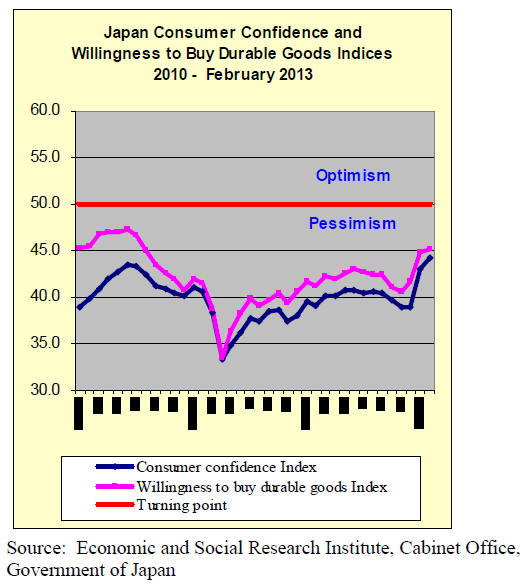
Energy imports drive up trade deficit
The weaker yen has adversely affected Japan’s trade deficit which rose to a
record US$17 billion in January 2013.
The rise was not wholly unexpected as the weaker yen had a big impact on
import bills plus the fact that January is, traditionally, a slow month for
exports.
The impact of the weaker currency was most apparent for energy imports which
have soared since the shutdown of almost all the nuclear reactors in the
country.
Power generation is now almost entirely dependant on oil and gas, both of
which have to be imported. Recent data show that imports of natural gas
increased by around 12% while oil imports increased over 30%.
Japan’s export performance in January was encouraging, growing 6.5% from
levels in 2012; however this was the first increase in eight months. This
good news was tempered however by the 7% plus rise in the cost of imports.
Many observers expect the Japanese government to push to restart some
nuclear reactors to cushion the impact of the weaker yen on energy import
bills.
2013 Japan/China trade prospects
Japan's total trade with China dropped 3.3% to US$333.664 billion in 2012,
marking the first drop since 2009. Imports from China rose 3.0% to
US$188.955 billion, setting a record high while exports to China fell 10.4%
to US$144.794 billion
As a result, Japan's balance of trade recorded a deficit of over US$44.246
billion. This was the first deficit exceeding US$40 billion.
Also, Japan's exports worldwide fell 2.4% from a year earlier to US$801.3
billion, a total decrease of US$19.5 billion, of which the drop in value of
exports to China reached US$16.8 billion.
The Chinese economy is strengthening from the decline in the third quarter
of 2012 and Japan's exports to China are showing signs of recovery.
However, the impact of the Chinese government emphasis on structural reform
could slow growth and Japanese analysts do not foresee the Chinese
government introducing large-scale stimulus measures to boost domestic
demand.
It is projected that, even if Japan’s exports to China improve, the rate of
improvement will be modest.
Japan’s imports from China are expected to continue upwards fueled by
development of Chinese production of machine parts and raw materials as well
as production and export of finished goods. On the basis of the assessment
made Japan-China trade throughout 2013 is expected to improve.
Machinery orders
The trends in the value of machinery orders are a good indication of
business sentiment in Japan. The latest data show that the total value of
machinery orders received by 280 manufacturers operating in Japan fell by
3.0% in January compared to the level in December.
Private-sector machinery orders, excluding those for ships and those from
electric power companies, fell by a seasonally adjusted by 13.1% in January.

Weak yen, unexpected consequences for Japanese manufacturers overseas
The Trade and Industry Ministry is forecasting trade with China, the number
one trading partner, should recover this year. In 2012 trade levels between
the two neighbours fell for the first time in three years because of a
territorial dispute and the slowdown in the Chinese economy.
The weaker yen also affected the trade deficit with China because Japan
imports so much from the country. Much of the import from China is of goods
manufactured in China by Japanese companies which relocated during the time
the yen was so strong.
Because the yen has weakened this ‘escape’ has the unexpected consequence of
making imports from Japanese manufacturers located in China more expensive
in the Japanese domestic market.
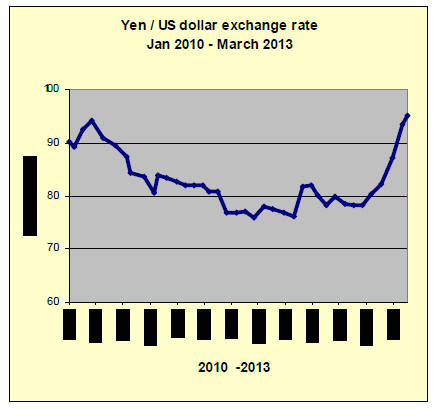
Housing starts in Japan
Housing starts in Japan fell 1.9 % in January compared to levels a month
earlier however, on a year to year basis, they have increased around 5%.
Over the past 5 months housing starts have exceeded levels in the same
period last year.
Housing starts in 2012 were 863 ,292 units slightly down on the average for
the previous 5 years (870,000 units). Investment in owner occupied homes in
January was up 2.2% while the number of units built for rent fell slightly.
The pace of starts in January was below expectations but it is difficult to
determine a trend from January data as there was an extended holiday period.
Another factor influencing the pace of starts was the severe weather across
Japan.
For the complete housing data see the Construction Research and Statistics
Office. Policy Bureau, Ministry of Land, Infrastructure, Transport and
Tourism website at:
http://www.mlit.go.jp/toukeijouhou/chojou/stat-e.htm

Trade news from the Japan Lumber Reports (JLR)
The Japan Lumber Reports (JLR), a subscription trade journal published every
two weeks in English, is generously allowing the ITTO Tropical Timber Market
Report to extract and reproduce news on the Japanese market.
The JLR requires that ITTO reproduces newsworthy text exactly as it appears
in their publication.
For the JLR report please see:
http://www.n-mokuzai.com/modules/general/index.php?id=7
Shortage of softwood plywood
Nationwide supply shortage of softwood plywood continues. Production of
plywood mills in Northern Japan has been down due to cold weather and heavy
snow and deliveries are largely delayed.
Meantime, the demand is steady and distributors are placing more orders, out
of which about a half seems to be speculative orders. Plywood mills have
been shipping contracted volume for house builders and precutting plants but
are declining to take spot orders.
Since last December, order balance increased to almost one month so that
shipment is delayed about two to three weeks even in February. The delayed
deliveries accelerate speculative orders.
The market last year had been down through the year by off balance of supply
and demand and the prices had kept falling so that dealers carry very little
inventories. Dealers had impression that the supply is ample and the volume
is available at any time but all of a sudden, things reversed with short
supply.
Mills in the North East have hard time in cold weather as logs are frozen so
that they have to go to hot bath to thaw then veneers are stick together
with ice so that they have to be separated sheet by sheet by hands to send
to dryer. This causes natural production drop.
Plywood
Domestic softwood plywood manufacturers are speeding up increase of the
prices. All through 2012, large shipments continued but the prices had kept
falling so they are determined to stabilize the market for long period this
year.
Delayed shipments of plywood started in December last year due to heavy
orders then there is no sign of ending of the delay in March yet after
peaking in February. The delay has been mainly for dealers but now even for
some precutting plants suffer such delayed shipment.
The manufacturers give priority to ship direct to precutting plants and
house builders then send the surplus cargoes to wholesalers and dealers.
Normally this time of the year is demand slow season with snow and cold
weather but this year is different. Precutting plants are busy with full of
orders then plywood mills in Northern Japan suffer frozen logs, which
reduces the production.
Under this situation, in wholesale channels, short supply lasted for two
months now and this pushes the prices up. Currently in Tokyo market, 12 mm
3x6 (special type/F 4 star) panel prices are 850-880 yen per sheet
delivered, 80-100 yen higher than February.
The prices of imported plywood are also rising. The suppliers’ offer prices
are high then with rapid progress of depreciation of the yen, the cost is
way up. The market prices eased some in mid February then as soon as high
offers by suppliers reached the market, the prices in Japan again took off.
Knowing that future arrivals would cost higher, there are some speculative
purchases in the market.
Market prices are 1,050-1,100 yen per sheet delivered on JAS concrete
forming 3x6 panel, 80 yen higher than February and 1,150-1,200 yen on 3x6
JAS concrete forming for coating, 20-50 yen up. Price trends are illustrated
below.
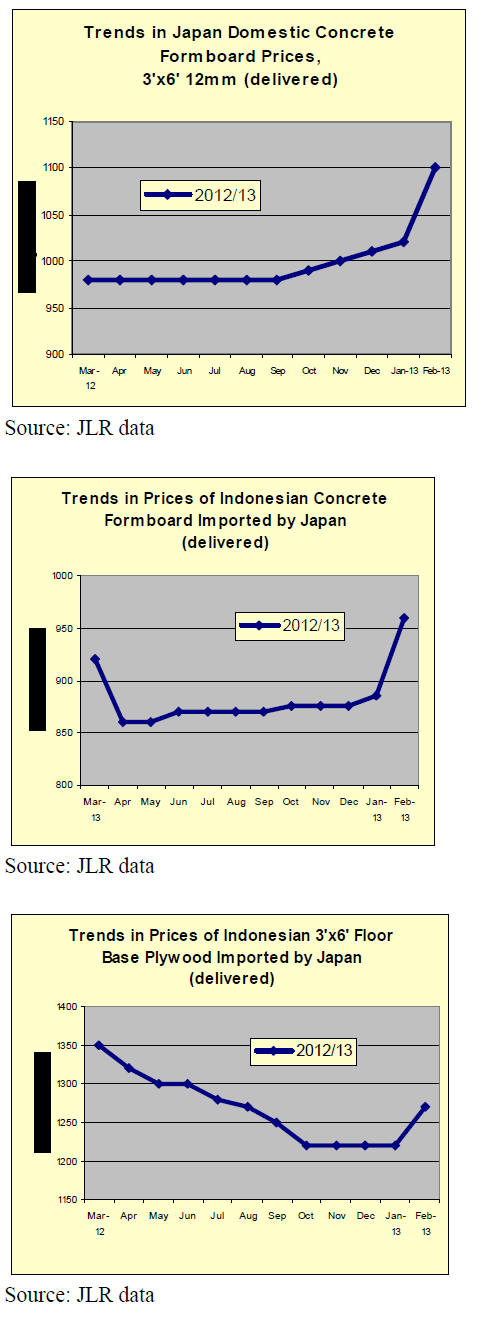
January 2013 furniture imports
The source and value of Japan’s office, kitchen and bedroom furniture
imports for January 2013 are shown below. Also illustrated is the trend in
imports of office furniture (HS 9403.30), kitchen furniture (HS 9403.40) and
bedroom furniture (HS 9403.50) between 2009 and Jan 2013.
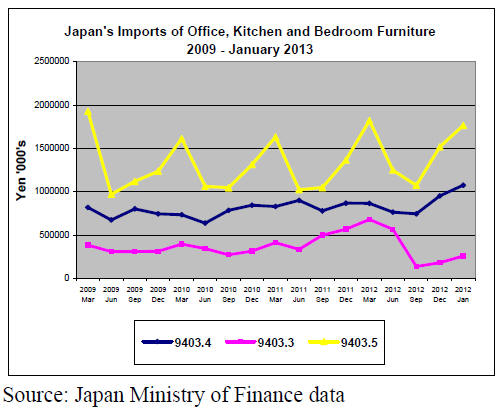
Office furniture (HS 9403.30)
January 2013 imports of office furniture totaled Yen 2.6 bil. Up around 7%
on imports in January 2012. In January 2013 China was the largest supplier
of office furniture to Japan accounting for approx 54% of imports. In
January 2013 the top five suppliers in terms of value of imports were China
(54%), Poland (10.1%), Indonesia (5.5%), Taiwan P.o.C (5.3%) and Portugal
(3.8%).
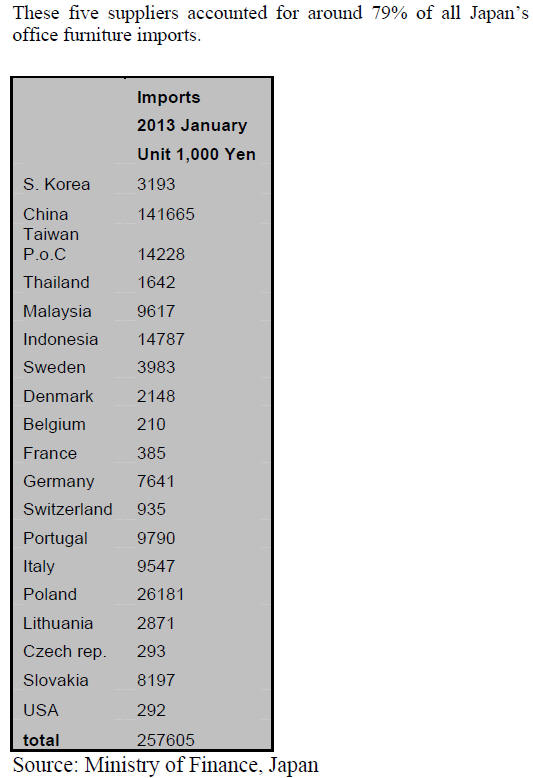
Kitchen furniture (HS 9403.40)
Kitchen furniture imports are the second largest segment of all furniture
imports into Japan after bedroom furniture. In January 2013 kitchen
furniture imports totaled Yen 10.8 bil. an increase of around 37% on levels
in January 2012.
The major suppliers in terms of value of imports in January 2013 were
Vietnam (39%), Indonesia (21%), Philippines (15%), China (12.6%) and the USA
(4.5%). In January all of the top suppliers increased sales to Japan except
China were the value of imports by Japan fell around 20%. The top five
suppliers accounted for over 90% of all kitchen furniture imports in January
2013.
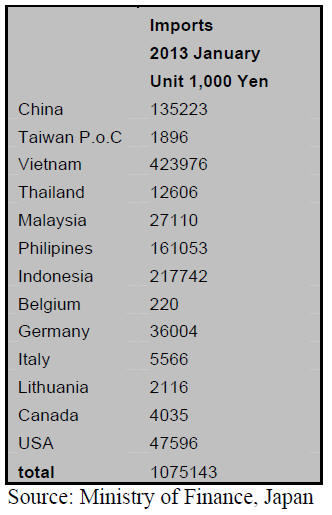
Bedroom furniture (HS 9403.50)
The value of bedroom furniture imports in January 2013 was almost 65% higher
than imports of kitchen furniture and some five times the value of office
furniture imports. The top five suppliers accounted for just over 93% of all
imports of bedroom furniture with the largest supplier being China (59%)
followed by Vietnam (22%), Malaysia (8.5), Thailand (2.5%).
In January 2013 bedroom furniture imports increased by around 5% compared
the levels in January 2012.
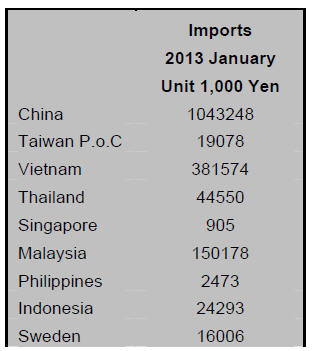 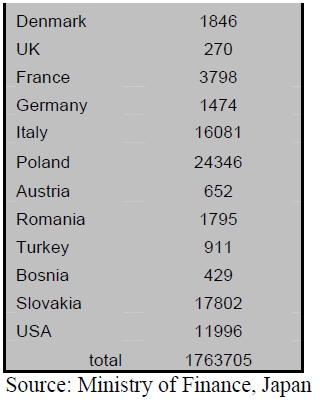
|